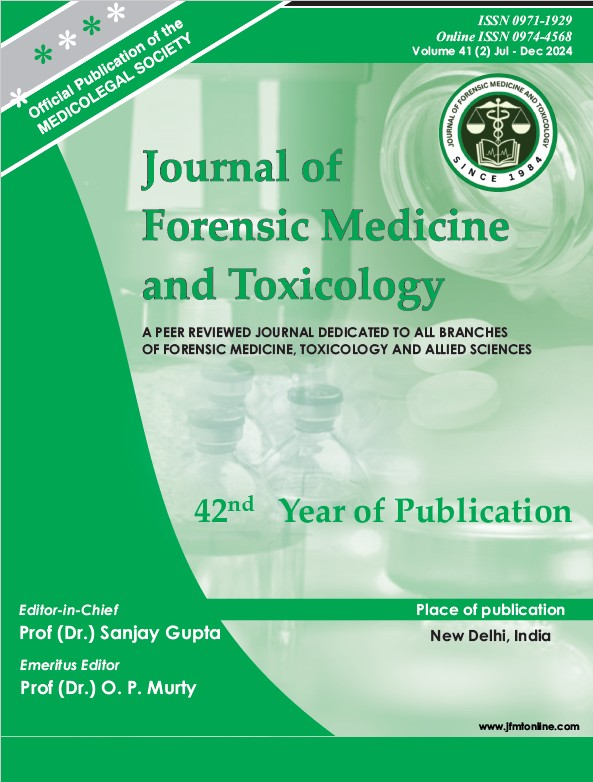Clinical and autopsy findings in Paraquat poisoning: A two year retrospective study
DOI:
https://doi.org/10.48165/jfmt.2025.42.3.6Keywords:
Herbicide, Reactive oxygen species, pulmonary fibrosis, AntidoteAbstract
Paraquat (PQ) is a highly toxic herbicide which causes cellular damage by production of superoxide radicals or other reactive oxygen species (ROS) and nitrite radicals. Agricultural health hazards of PQ are seen among the handlers due to its direct effect. However, most fatal toxicity is seen following ingestion; which is mostly done for self-harm. The target organ of PQ toxicity is lungs and kidney causing very rapid death following extensive pulmonary fibrosis and kidney damage. It also causes local effect on oral cavity by extensive erosion of oral mucosa and tongue. There is no specific treatment due to lack of antidot. In our study, we have seen 57 cases of PQ poisoning brought to our tertiary care centre in southern part of India. Out of these cases, 21 pa tients were brought directly by family members and remaining were referred from outside. All of the patients received conservative treatment and there was good clinical outcome with 15 deaths. Autopsy was conducted in all deaths in our mortuary. The autopsy findings also highlighted extensive pulmonary damage in all cases.
Downloads
References
Raghu K, Mahesh V, Sasidhar P. Paraquat poisoning: a case report and review of literature. J Family Community Med. 2013;20(3):198–200.
Scherrmann JM, Houze P, Bismuth C, Bourdon R. Prognostic value of plasma and urine paraquat concentration. Hum Toxicol. 1987;6(1):91–93.
Suntres ZE. Role of antioxidants in paraquat toxicity. Toxicology. 2002;180:65–77.
Dinis-Oliveira RJ, Duarte JA, Sánchez-Navarro A. Paraquat poisonings: mechanisms of lung toxicity, clinical features, and treatment. Crit Rev Toxicol. 2008;38:13–71.
Sukumar CA, Shanbhag V, Shastry AB. Paraquat: the poison potion. Indian J Crit Care Med. 2019;23:S263–S266.
Lock EA, Wilks MF. Chapter 70 – Paraquat. In: Krieger RI, Krieger WC, editors. Handbook of Pesticide Toxicology. 2nd ed. San Diego, CA: Academic Press; 2001. p.1559–1603.
Yoon SC. Clinical outcome of paraquat poisoning. Korean J Intern Med. 2009;24:93–94.
Gawarammana IB, Buckley NA. Medical management of paraquat ingestion. Br J Clin Pharmacol. 2011;5:745–757.
Gupta N, Chugh A, Kanwar BS, Lamba BMS. A case report of paraquat poisoning. JIACM. 2018;19(3):210–211.
Sahu MR, Sharma M, Rath B, Joseph T, Padhy KS. Clinical and pathological profile of paraquat poisoning cases – a cross-sectional study in Odisha, India. Indian J Forensic Community Med. 2020;7(4):210–215.
Yi R, Zhizhou Y, Zhaorui S, et al. Retrospective study of clinical features and prognosis of edaravone in the treatment of paraquat poisoning. Medicine. 2019;98:e15441.
Elenga N, Merlin C, Le Guern R, et al. Clinical features and prognosis of paraquat poisoning in French Guiana: a review of 62 cases. Medicine. 2018;97:e9621.
Yadav M, Shah NA, Ghimire R, Lamichhane S, Yadav S, Yadav D, Jha SK. Acute paraquat poisoning in an adolescent with compromised outcome: a case report. SAGE Open Med Case Rep. 2024;12:1–6.
Chandra A, Shah KA, Mahato S, et al. BMJ Case Rep. 2021;14:e246585. doi:10.1136/bcr-2021-246585.
Li LR, Sydenham E, Chaudhary B, Beecher D, You C. Glucocorticoid with cyclophosphamide for paraquat-induced lung fibrosis. Cochrane Database Syst Rev. 2014;CD008084.
Lin JL, Wei MC, Liu YC. Pulse therapy with cyclophosphamide and methylprednisolone in patients with moderate to severe paraquat poisoning: a preliminary report. Thorax. 1996;51(7):661–663.
Gawarammana I, Buckley NA, Mohamed F, Naser K, Jeganathan K, Ariyananada PL, et al. High-dose immunosuppression to prevent death after paraquat self-poisoning – a randomised controlled trial. Clin Toxicol (Phila). 2018;56(7):633–639.
Montoya-Giraldo LF, Diaz UE, Gomez J, Quintero J, Zuluaga AF. Use of low-molecular-weight heparin in severe paraquat poisoning: a case report. J Med Case Rep. 2020;14:240. https://doi.org/10.1186/s13256-020-02565-9




